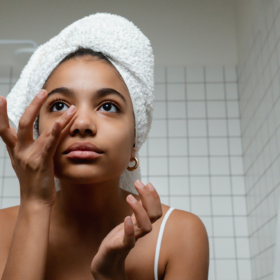
What is vaginal atrophy?
In this article
What's the lowdown?
Vaginal atrophy is a condition covered under the umbrella term genitourinary syndrome of menopause (GSM)
Vaginal dryness, painful sex, recurrent urinary tract infections and vaginal itching are among some of the symptoms
Vaginal atrophy and GSM are common, especially in women over the age of 45 due to the natural drop in oestrogen during this time
The symptoms of vaginal atrophy and GSM may be similar to, or disguise other infections
Creams and gels containing oestrogen have been found to improve symptoms of vaginal atrophy and GSM, and are safe and easy to use
If you have other concerning symptoms or you’re just not sure, always talk to a doctor
Riddle me this: It’s dry, itchy, occasionally painful, and hates sex. It’s… your vagina. Unfortunately, vaginal atrophy and genitourinary syndrome of menopause is a reality for more of us than we let on.
What is genitourinary syndrome of menopause?
More often than not it isn’t your vagina alone giving you grief. The majority of women experiencing symptoms of vaginal atrophy will likely also have urinary and other pelvic problems. This is why vaginal atrophy as a term is now covered under the umbrella of genitourinary syndrome of menopause (GSM). This reflects the full spectrum of symptoms that can affect the vulva, vagina and urinary tract due to low oestrogen levels in the time leading up to, during and after the menopause. It is a complex group of symptoms and problems involving both your genital and urinary tissues and can affect each one of us differently.
What is vaginal atrophy?
Vaginal atrophy describes the thinning of the vaginal tissue due to a decrease in oestrogen. Oestrogen assists with keeping the lining of the vagina elastic, thick and well lubricated; so when oestrogen levels drop, your oestrogen sensitive tissues tend to flake on you. This process typically happens during menopause when your body naturally slows down the production of oestrogen as your reproductive years come to an end. The average age of menopause in the UK is 51 and symptoms can start years before this. This can however also happen to anyone with a vagina who is younger than 45 and not necessarily past or going through menopause.
Symptoms of vaginal atrophy include (but are definitely not limited to):
- Feeling itchy around your vulva. The skin and tissue here is some of the most sensitive in our body so if something isn’t right, you’ll know about it
- Vaginal dryness
- Feeling soreness around your vulva and the entrance of the vagina. Burning is often a term used to describe the type of pain.
- Pain during or after sex. This often happens at the entrance of the vagina and is referred to as ‘superficial dyspareunia’
- Light bleeding after sex. This is due to small breaks in the fragile vaginal tissue – think cracked and dry skin – which may bleed
- Urinary symptoms. The tissues around the urinary tract are also sensitive to hormonal changes. Symptoms include increased frequency (needing to pee more often), urgency (needing to pee NOW), dysuria (painful pee) and nocturia (annoyingly waking up during the night to pee). Urinary tract infections are commonly linked to vaginal atrophy and dryness.
- Decreased arousal, lubrication, orgasm and desire. (This is the actual worst, but we have a great webinar on sex, libidos and orgasms if this is getting you down)
What are the causes of vaginal atrophy/GSM?
For most, it’s the often dreaded menopause that starts the domino effect low oestrogen brings. However, not only those going through menopause are affected by this. Medical treatments such as certain types of chemotherapy and/or radiation treatment, and surgical removal of your ovaries, as well as childbirth, breastfeeding and some hormonal contraceptives (especially those containing only progestogen) can cause symptoms associated with vaginal atrophy and GSM.
How common is vaginal atrophy/GSM?
In short – very! Studies from across the globe have proved that vaginal atrophy/GSM is common and terribly under-reported. One study showed GSM affects a whopping 70% of post-menopausal women in Spain, the majority of which were undiagnosed. Another study found that 19% of 40 to 45 year old women and 50% of postmenopausal women in the UK experienced GSM.
What are the differences between vaginal atrophy and vaginal dryness?
Although seemingly very similar and often confused for one another – vaginal dryness is a symptom (something experienced by you) of vaginal atrophy/GSM (the condition) rather than a condition on its own. Vaginal dryness can also be associated with other conditions such as infections.
What are the differences between vaginal atrophy and a yeast infection?
Vaginal dryness and some other symptoms associated with vaginal atrophy/GSM may also be experienced if you have a yeast infection known as thrush. Symptoms include soreness and itching around the vulva, pain around the entrance to the vagina during sex, inflamed skin that bleeds easily and stinging when passing urine. Thrush does not affect your oestrogen levels or lead to vaginal atrophy.
Yeast infections or thrush tend to have the hallmark symptom of thick, white discharge as well as vaginal irritation, itching and urinary symptoms. This is caused by the overgrowth of yeast cells which naturally occur within the vagina, the most common being Candida. Causes of thrush include recent use of antibiotics, the use of intimate hygiene products and an immune system which isn’t functioning well.
Potential complications of vaginal atrophy/genitourinary syndrome
Quality of life
Quality of life is going at the top of my list because, historically, it’s been left off altogether. GONE are the days where women past a certain age (or in this case a certain vaginal status) are put onto the proverbial shelf. And it’s about time. One study in the USA showed that 80% of women experiencing vaginal discomfort due to GSM felt it had a negative impact on their life. Loss of intimacy, reduced sexual enjoyment and a negative effect on sleep were also noted as complications.
Infections
Changes in vaginal tissue due to low oestrogen can make you more prone to infections or changes in the vaginal microbiome, leading to conditions such as bacterial vaginosis and thrush. Likewise you may be prone to urinary tract infections (UTIs).
Pelvic floor muscle weakness
Urinary incontinence (usually stress incontinence, i.e the post-sneeze pee) and pelvic organ prolapse are some of the complications due to having weakened pelvic floor muscles. This is because oestrogen also has a positive effect on muscle tissue. For more advice on keeping a healthy pelvic floor and other conditions, speak to our pelvic health physiotherapist.
How to treat vaginal atrophy/genitourinary syndrome
Recognition of menopause and hormone related conditions has thankfully improved drastically over the last few years with the increasing emphasis on women’s health (it’s about time!). Ideally, the aim of treatment is to get you and your vagina back to 100% by replacing what’s missing, which in most cases, is oestrogen! Multiple options are available to improve symptoms including systemic hormone replacement therapy (HRT), vaginal oestrogen cream and other strategies to help relieve symptoms.
Hormone replacement therapy (HRT)
For people struggling with other menopausal symptoms, such as hot flushes or low mood, as well as GSM symptoms, replacement oestrogen can be prescribed. This can be in the form of pills, patches, gels or sprays, for example. You’ll need your doctor to go through the risks and benefits and prescribe this treatment for you. For the majority, HRT provides more benefits than risks. If you have a womb you’ll need to take progesterone alongside oestrogen, as oestrogen alone can promote overgrowth of the womb lining. This is usually effective in treating most of the symptoms of menopause but unfortunately 10 to 25% of those on HRT will still have ongoing vaginal atrophy/GSM symptoms. Testosterone replacement can also be effective at helping symptoms of GSM, but is usually only prescribed for women experiencing reduced sexual desire despite taking HRT.
Vaginal oestrogen
Sometimes, you just need to add what’s missing directly to where it’s needed. Oestrogen-containing gels, creams, pessaries and rings applied directly to the vagina have been found to be very effective and usually provide a quick improvement in vulval, vaginal and urinary symptoms, although it can take a couple of months for you to notice beneficial effects. Treatment with vaginal oestrogen is safe and can be used in the long term to manage symptoms. Vaginal oestrogen will soon be available to purchase from The Lowdown – so keep your eyes peeled for updates!
Women with a history of breast cancer can usually use vaginal oestrogen but will need to discuss the risks and benefits with a doctor who can then prescribe this for them. Pessaries containing Dehydroepiandrosterone (DHEA) – a mouthful, we know – inserted into the vagina are an alternative. DHEA has also been shown to improve GSM symptoms as it is transformed into oestrogen in the body.
Symptomatic treatment
WE LOVE LUBE! And you should too. Water-based lubes are best, as oil-based can make a bad situation worse by causing irritation and have shown to make latex condoms less effective. Vaginal moisturisers are also available and often help with vulval sensitivity.
Get Yes water-based lube from Amazon (we love this and earn a small commission).
A few final lifestyle tips
We’ve said it before and we’ll say it again, please please please don’t douche. Intimate hygiene products often make things worse by altering vaginal pH. Wearing looser clothing, avoiding perfumed panty liners and not wearing synthetic underwear may help manage GSM symptoms. Similarly, stopping (or never starting) smoking and maintaining a healthy lifestyle can contribute to symptom improvement as well as your overall health.
When to see a doctor about vaginal atrophy
Hormone replacement therapy will require a prescription and therefore, a trip to your GP. This is because certain risks and benefits involved with the use of HRT need to be evaluated to make sure you’re being managed safely. These include a previous personal or a family history of certain cancers. Women still need to consider contraception until they are effectively post menopausal and this can be used alongside or instead of HRT.
Signs that something else might be going on include recurrent infections or symptoms despite completing or ongoing treatment, unintended loss of weight, new or irregular bleeding and unusual discharge. If you’re having any of these symptoms or just aren’t sure, it’s best to get a professional’s advice. We have a team of amazing women’s health GPs at The Lowdown who can assist in answering any questions you might have.
Our medical review process
This article has been medically reviewed for factual and up to date information by a Lowdown doctor.





